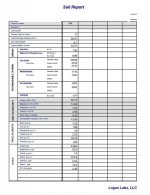plantingplants
Active member
So here it is. This is coots' mix modified by shcrews. Here are the ingredients:
12.75 yards lava rock
12.75 yards peat*
12.75 yards fish compost
2 yards bu blend compost
250 lbs kelp meal
240 lb 4-3-0 crab meal
280 lbs gypsum
250 lbs oyster shell*
130 lbs neem cake
100 lbs alfalfa meal
1000 lbs glacial rock dust
Any input? I got an analysis from leadsled, and here is the action plan I drew up from lead's advice:
Flush with low sodium water to leach sodium (probably came from fish compost) and sulfur (which probably came from gypsum)*
Add spectrum extra for sodium.
Grow dutch white clover in pots, do not till in, to pull out excess.
Test water to make sure no excess sodium.*
Foliar weekly with agsil, Ca, mn, and mo, due to high Iron (from glacial rock dust), excess nitrate, and K/Ca saturation over 10%, which will impede micro uptake.
Here are my recommended amendments per yard:
3000*g -*Agricultural Lime. Calcium Carbonate. (Microna Ag lime*
91*g - Manganese (Mn) Sulfate**
9*g -*Copper*(Cu) Sulfate*Pentahydrate*(Blue)*
23*g -*Zinc*(Zn) Sulfate**
9*g - Borax (10% B)*
454 grams biochar.*
60 grams azomite
2.5 grams of cobalt sulfate per yard. .2 grams of sodium molybdate dihydrate per yard.
My combined K and sodium are just above 10% which may limit manganese, according to leadsled. Can anyone explain why that is? Does it have to do with the charge strength of those cations?
What do folks think about micronutrient forms? Glycine chelates? I'm tryin to avoid sulfates since it's already too high.
Does anyone know of a low or no sulfur and iron micronutrient blend? I have too much of those already. I think I 'll have to make it myself.
Also does anyone know why I would have balls of half composted grayish green manure in my soil? You would think Bu's blend would be fully composted?
12.75 yards lava rock
12.75 yards peat*
12.75 yards fish compost
2 yards bu blend compost
250 lbs kelp meal
240 lb 4-3-0 crab meal
280 lbs gypsum
250 lbs oyster shell*
130 lbs neem cake
100 lbs alfalfa meal
1000 lbs glacial rock dust
Any input? I got an analysis from leadsled, and here is the action plan I drew up from lead's advice:
Flush with low sodium water to leach sodium (probably came from fish compost) and sulfur (which probably came from gypsum)*
Add spectrum extra for sodium.
Grow dutch white clover in pots, do not till in, to pull out excess.
Test water to make sure no excess sodium.*
Foliar weekly with agsil, Ca, mn, and mo, due to high Iron (from glacial rock dust), excess nitrate, and K/Ca saturation over 10%, which will impede micro uptake.
Here are my recommended amendments per yard:
3000*g -*Agricultural Lime. Calcium Carbonate. (Microna Ag lime*
91*g - Manganese (Mn) Sulfate**
9*g -*Copper*(Cu) Sulfate*Pentahydrate*(Blue)*
23*g -*Zinc*(Zn) Sulfate**
9*g - Borax (10% B)*
454 grams biochar.*
60 grams azomite
2.5 grams of cobalt sulfate per yard. .2 grams of sodium molybdate dihydrate per yard.
My combined K and sodium are just above 10% which may limit manganese, according to leadsled. Can anyone explain why that is? Does it have to do with the charge strength of those cations?
What do folks think about micronutrient forms? Glycine chelates? I'm tryin to avoid sulfates since it's already too high.
Does anyone know of a low or no sulfur and iron micronutrient blend? I have too much of those already. I think I 'll have to make it myself.
Also does anyone know why I would have balls of half composted grayish green manure in my soil? You would think Bu's blend would be fully composted?
Attachments
Last edited:




